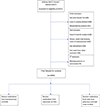The Source of Purchased Medications and Its Impact on Medication Mistakes and Hospitalizations
- PMID: 35148208
- PMCID: PMC9205362
- DOI: 10.3928/19404921-20220131-02
The Source of Purchased Medications and Its Impact on Medication Mistakes and Hospitalizations
Abstract
Older adults self-administer prescribed medication regimens to treat chronic diseases, which can lead to mismanagement, medication-related harm, and hospitalization. Using the National Health and Aging Trends Study (NHATS) dataset, we examined the extent to which the medication source could impact the occurrence of self-reported medication mistakes and hospitalizations in community-dwelling adults aged ≥65 years who managed medications independently (N = 3,899). The majority (65%) picked up medications, 18% had medications delivered, and 17% used both methods. Compared to those picking up their medications, those using delivery only were less likely to have a hospital stay (odds ratio [OR] = 0.61, 95% confidence interval [CI] [0.51, 0.94]) but had no difference in odds of medication mistakes (OR = 1.13, 95% CI [0.57, 2.23]). Those using both methods were more likely to report hospital stays (OR = 1.43, 95% CI [1.11, 1.85]) and medication mistakes (OR = 1.65, 95% CI [1.00, 2.73]). Health care providers should consider medication source when assessing older adults' ability to safely self-manage medications. [Research in Gerontological Nursing, 15(2), 69-75.].
Figures


References
-
- Center for Disease Control (CDC). (2017). Medication safety program. https://www.cdc.gov/medicationsafety/program_focus_activities.html
-
- Jamerson BD, Fillenbaum GG, Sloane R, & Morey MC (2016, Jun). A new method of identifying characteristics of needing help to take medications in an older representative community-dwelling population: The older adults medication assist scale. Journal of the American Geriatrics Society, 64(6), 1195–1202. 10.1111/jgs.14166 - DOI - PMC - PubMed
-
- Kasper JD & Freedman. VA. (2021). National Health and Aging Trends Study User Guide: Rounds 1–10 Beta Release. Baltimore: Johns Hopkins University School of Public Health. www.NHATS.org.
Publication types
MeSH terms
Grants and funding
LinkOut - more resources
Full Text Sources

